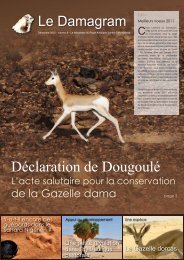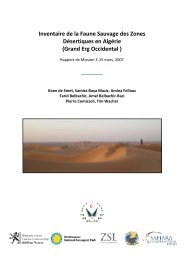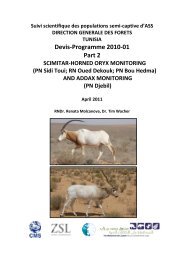The Biology, Husbandry and Conservation Scimitar-horned Oryx ...
The Biology, Husbandry and Conservation Scimitar-horned Oryx ...
The Biology, Husbandry and Conservation Scimitar-horned Oryx ...
You also want an ePaper? Increase the reach of your titles
YUMPU automatically turns print PDFs into web optimized ePapers that Google loves.
23<br />
Part 2: <strong>Husb<strong>and</strong>ry</strong> Guidelines<br />
more peaceful bachelor group. However, this is not an appropriate method because it is not<br />
possible for the animals to contribute to the captive breeding programme after the operation.<br />
<strong>The</strong> key factors dictating levels of aggression in bachelor groups appear to be available space,<br />
group size, <strong>and</strong> age of individuals:<br />
Problems tend to occur when space is limited <strong>and</strong> the group size is small. If the enclosure is<br />
large, the animals are able to avoid one another. If there are many animals in the group, the<br />
attention of the dominant male is directed towards many opponents, <strong>and</strong> so attacks are not<br />
concentrated on any particular individual (Krebs <strong>and</strong> Davies, 1993). This is analogous to several<br />
bachelors entering the territory of a conspecific dominant male <strong>and</strong> creating a situation in which<br />
the energy expenditure needed to repel those incursions is too great (Geist, 1968; Gosling,<br />
1986).<br />
In addition, problems will tend to occur when all males are greater than 22.5 months in age<br />
<strong>and</strong> are sexually mature. Conversely, an obvious stratification of ages should produce a<br />
mostly peaceful group. If one animal is about two years older than its group members, it is<br />
able to hold the alpha position unchallenged. Moreover, this animal will act as peacemaker<br />
<strong>and</strong> prevent aggression amongst other members of the group (Mungall & Sheffield, 1994;<br />
Engel, 1997a).<br />
In bachelor groups, there is no behavioural difference between individuals that have already<br />
produced offspring <strong>and</strong> those that have not been used for breeding. Neither the presence of<br />
females of other bovid species, nor a lack of linearity in the rank order affects the bachelor<br />
group negatively (Engel, 1997a).<br />
Assuming the above points are taken into consideration, the formation of bachelor groups is<br />
highly recommended, particularly as all-male group may play an important role in the<br />
socialisation of young males. In mixed herds, the lower ranking male adopts the female role in<br />
mating behaviour between two males. In bachelor groups there is no such correlation between<br />
rank <strong>and</strong> role. This supports the hypothesis that young male scimitar-<strong>horned</strong> oryx in a bachelor<br />
herd perfect their sexual behaviour through practical training. Young subdominant males in<br />
mixed groups do not have this opportunity. Furthermore, it is evident that learning is more<br />
important in all-male groups than the demonstration of dominance (Engel, 1997a).<br />
A final observation is that the level of aggression reported in all-male groups of scimitar<strong>horned</strong><br />
oryx may be a particular phenomenon of artificially well-fed zoo populations. In the<br />
wild, scimitar-<strong>horned</strong> oryx live in semi-arid <strong>and</strong> desert habitats where they spend most of<br />
their time searching for food, <strong>and</strong> by the end of the hot season they are usually in very poor<br />
condition (Gillet, 1966a; Newby, 1974). Bachelor groups in particular are forced to live in the<br />
least favourable habitats (Bigalke, 1974; Gosling, 1974; Montfort-Braham, 1975; Attwell,<br />
1982). Although the mechanisms by which diet modulates gonadotrophin secretion are<br />
unclear, there is substantial evidence for a positive correlation between nutrition <strong>and</strong><br />
testosterone levels (Setchell et al., 1965; Millar & Fairall, 1976; Gauthier & Coul<strong>and</strong>, 1986).<br />
Furthermore, there is a positive correlation between testosterone <strong>and</strong> social aggressive<br />
behaviour (Illius et al., 1976, 1983; Sapolsky, 1982, 1993; Bouissou, 1983; Sachser & Pröve,<br />
1986). It may be possible to reduce aggression in zoo-based bachelor groups by modifying the<br />
diet. This would be in perfect accordance with what is known about the ultimate <strong>and</strong><br />
proximate factors of all-male groups (Engel, 1997a).





